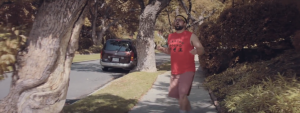This video has been seen 145 million times on YouTube.
It’s not uncommon to use “real people” in videos. Sara Bareilles did it recently in Brave.
I don’t know about you, but often this exercise makes me uncomfortable. These days, I know I am supposed to distinguish piously between “real people” and “celebrities.” I know we believe “real people = authentic” and “celebrities = fake.”
I try, I really do. But finally I end up feeling that real people (i.e., you and me) are being patronized. Clearly, someone in the band stayed up too late talking about crowd-sourcing, fan bases, and the importance of fostering the people. So the next video just had to have real people in it.
But there are two problems. First, real people aren’t always very interesting. Second, they aren’t very real. The process of shooting video sometimes provokes what we might call the Karaoke effect. We are not recruiting real people for the video. We are recruiting people who have spend a lot of time pretending to be famous people. So what we really get for the video are people who have pretended to be celebrities now being asked to pretend to be real people.
A different proposition, surely. In our Karaoke culture, a camera is a dangerous ontological weapon. It transforms real people into fake celebrities. And we’re now trapped. We tire of celebrity culture and wish to escape it. But here at least we can’t. Everyone has felt the vampiric bite of fame. We may not be celebrities but we can’t ever go back to being “real.” (Whatever that was, and most anthropologist would insist that “real” is constructed just as much as “phony” is.)
[By the way, this is what it is to live in a media saturated society. A police detective told me once that he has a hard time interviewing suspects. They have seen so many Law and Order interrogations, they believe they know exactly how the interview is supposed to go and start answering questions he has not asked.]
BUT MY POINT IS SIMPLE (and I am sorry to have taken 7 paragraphs to get there): The Happy video from Pharrell does not make me feel this way. I like watching these people dance and sometimes sing. Evidently others do too. That’s the only way Happy could score 145 million views.
The question is why. What does Happy do differently? How do these “real people” differ from the real people who feature so prominently in music, marketing and advertising?
Part of the answer is that this video comes from started as a 24 Hour project. So the producers could choose the best frame out of every 360 frames, as it were. They had a lot to work with.
Second, most of the people in the Pharrell video are auditioned. So they are not that real after all. It looks like the video is an act of perfect spontaneity, that they just took the camera out into the streets of LA, but no. Some of these actors are so good, they accomplished sprezzatura: they concealed their art with art.
But there is some ineluctable mystery here. These performances are dazzling. It feels like these people “own” their performances. And it’s important for us to know why. Every cultural artifact has something to learn here. Pharrell and We Are From LA have solved an essential problem. It’s important to now how
Here are some of my favorite performances. I hope Pharrell and creators We Are From LA will forgive me this use of these materials. (Before they object, I would ask that they keep in mind that Nardwaur sent me.) Also, if the people pictured happen to see this post, I hope they get in touch so that I can name them.
Look for these designations: Eeriest imitation, best dancing, most beautiful woman, scariest handbag, etc. Slide 18 is for me the splendid moment. Two girls swaying in a car. Perfect.
I think why this video works so well is that it reverses the polarity of popular culture and the present craze for “real people.” Too often, the real people are forced-marched into the video, there to Karaoke as best they can. But in the Happy case, the song goes to them. These real people are not conscripted. The “press” runs the other way.
One measure of success: there are celebrities in this video (Jamie Foxx, Steve Carrell, Kelly Osbourne) but they do not matter to the video very much, and almost feel a little additional, as if horning in. As in, “who invited you?” Kelly Osbourne is perhaps the exception. I’ve always thought of her as someone who was merely famous for being famous, but with that weird “air square” she does something somehow sublime and redeems herself. Less a celebrity and now interesting. This video has something that is capable of rescuing celebrities from their celebrity. And that’s saying something.
There were ideas at work here. Here’s a passage from a wonderful piece in FastCo by Mary Kaye Shilling.
Those chosen by audition had the advantage of getting the song in advance, allowing them to rehearse their moves. But on the day itself, everyone got just one take, including Pharrell. “That’s what accounts for the charm,” says [iamOther VP Mimi] Valdes. “Everyone knew they had one shot–this was their moment to go all out, and we love that.”
“The video’s imperfections, the funny bloopers and mess-ups, are what give it character,” says Pharrell, whose own performances alternated between what he calls “semi-choreographed” (see the bowling alley at 11:00 p.m.) and improvisation. “I’m not interested in perfection. It’s boring. Some of my favorite moments are accidental.”
Lots of meaning makers in the present day continue to have what we might call a “sound stage” mentality. They manhandle reality for our larger cultural purposes. But I think this Happy video makes it clear that the more sensible, indeed, the necessary strategy is to let the brand out into the world, there to take on the content, color, and sheer propulsive force of what happens there.
Hat’s off to the following creatives:
Jett Steiger, Jon Beattie, Alexis Zabe, Mimi Valdez, Clement Durou, Pierre Dupaquier, Pharrell, WAFLA, Iconoclast, and iamOther




















